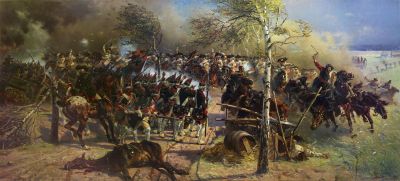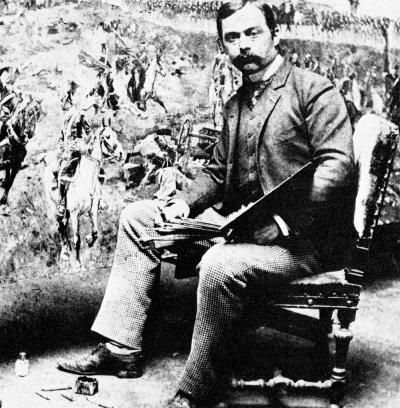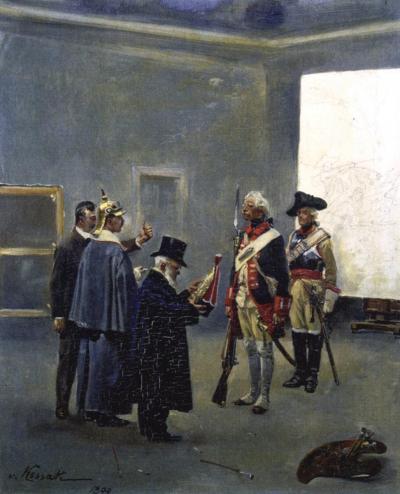Wojciech Kossak: The Battle of Zorndorf (1758), 1899

Wojciech Kossak was born in Paris in 1856 where his parents lived for several years. His father Juliusz Kossak (1824-1899) was also a painter whose favourite themes were horses, battles and historical portraits. In 1869 the family moved to Kraków. In summer 1871 he began to study painting at the Kraków School of Art (Szkoła Rysunku i Malarstwa) under Władysław Łuszczkiewicz. And from 1874 to 1866 he continued his studies at the Academy of Pictorial Arts in Munich. Here, since the 1860s, there had grown up a veritable “colony of Poles” around the Polish painter Józef Brandt. In 1877 he travelled to Paris, where one of his teachers at the École des Beaux-Arts was Léon Bonnat. In 1884 he returned to Kraków, found a wife and painted in his own workshop for the following ten years. In 1893 he collaborated with the Lemberg painter Jan Styka on the “Panorama of the Battle of Racławice”, and one year later this was shown in Lemberg/Lwów (it can now be seen in Breslau/Wrocław). The cycloramic painting shows the victory of the Polish peasant army (they were only armed with scythes) under the leadership of Tadeusz Kościuszko, over the troops of the Czar on 4 June 1794 in the region of Kielce.
In 1895 Kossak accepted an invitation from his colleague Julian Fałat – like Kossak he had also studied painting in Kraków and Munich – to come to Berlin. Since 1889 Fałat had been active as a painter at the court of Wilhelm II, and for a long time he had been planning a broad panorama to depict “The Crossing of the Beresina by Napoleon’s troops”. And because Kossak had made a name for himself with his Panorama of Racławice – since its first showing visitors had been streaming to see it as a symbol of Polish nationalism – he seemed to be the right person for this task. Working with other Polish and German painters, Fałat and Kossak managed to complete the Beresina Panorama within the space of sixteen months. The painting, which was 17 metres high and 115 metres in length, was first shown to the general public on 1 April 1896 in Berlin. The Kaiser made Kossak’s acquaintance during a visit to view the panorama. In the following years Kossak specialised in horses and battle scenes which he painted for members of the Berlin upper classes and Prussian aristocrats in his workshop in Charlottenburg. In spring 1897 he managed to attract the attention of the Kaiser once again. Wilhelm invited him to some autumn manoeuvres and put a workshop at his disposal in Monbijou Palace not far from the City Palace. It had served as the Hohenzollern Museum since 1877.








